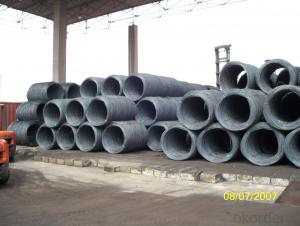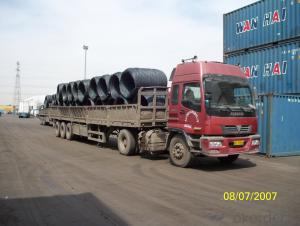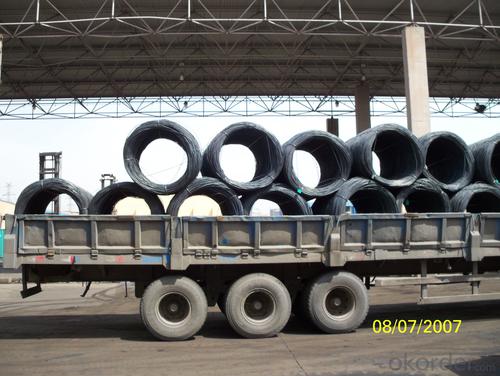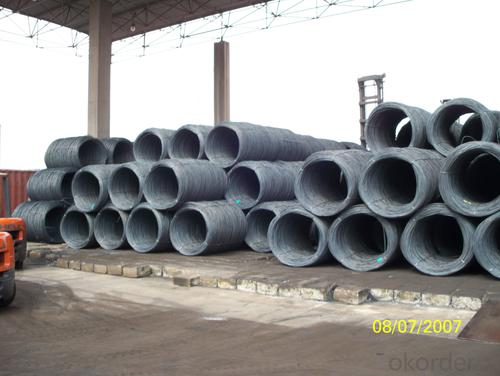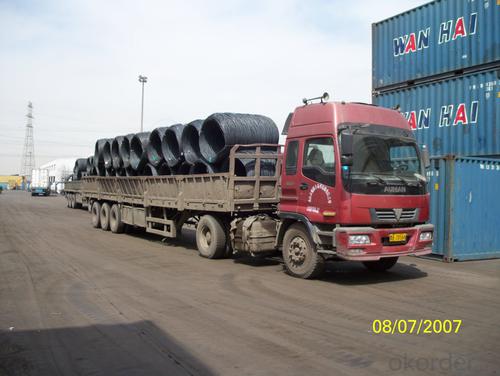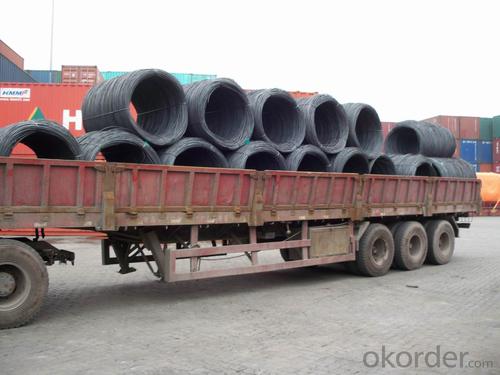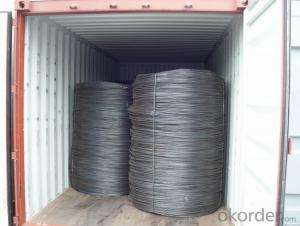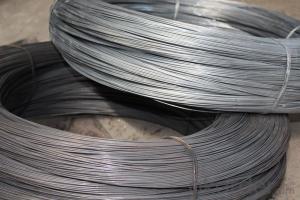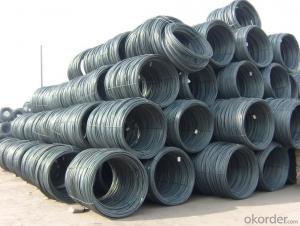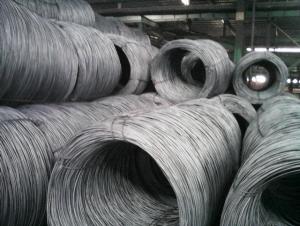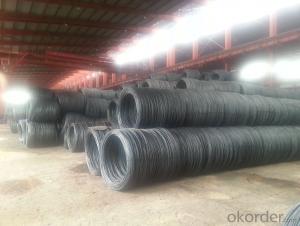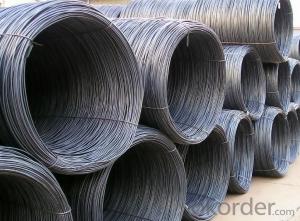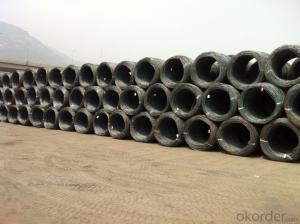SAE1006Cr Carbon Steel Wire Rod 7.5mm for Welding
- Loading Port:
- Shanghai
- Payment Terms:
- TT OR LC
- Min Order Qty:
- 100 m.t
- Supply Capability:
- 30000 m.t/month
OKorder Service Pledge
OKorder Financial Service
You Might Also Like
Specification
Description of SAE1006Cr Carbon Steel Wire Rod 7.5mm for Welding:
OKorder is offering Color Coated Steel Coil Prepainted Steel Coil at great prices with worldwide shipping. Our supplier is a world-class manufacturer of steel, with our products utilized the world over. OKorder annually supplies products to European, North American and Asian markets. We provide quotations within 24 hours of receiving an inquiry and guarantee competitive prices.
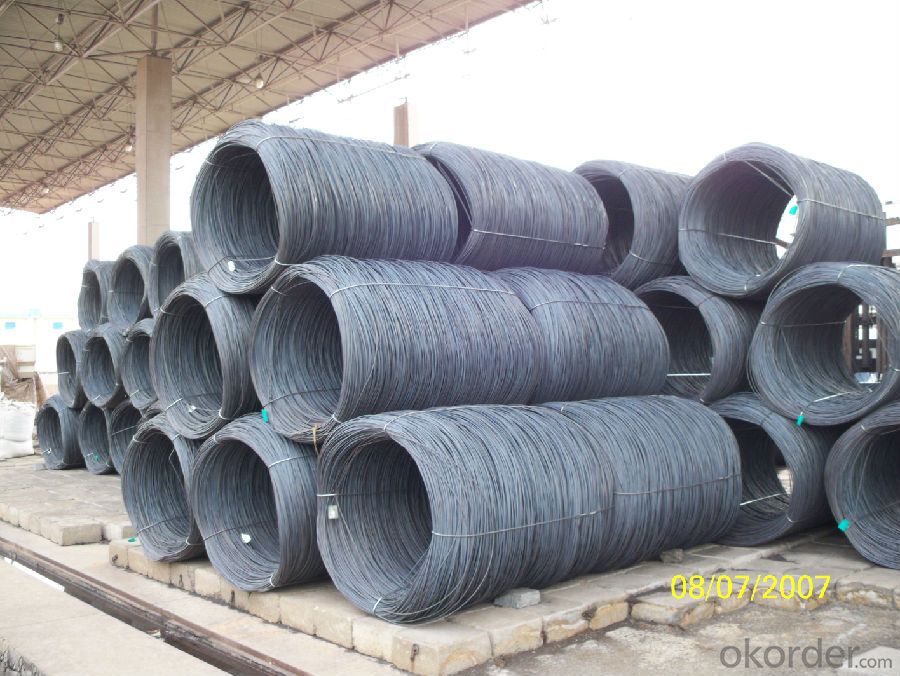
Applications of SAE1006Cr Carbon Steel Wire Rod 7.5mm for Welding:
Color Coated Steel Coil Prepainted Steel Coil are ideal for structural applications and are widely used in the construction of buildings and bridges, and the manufacturing, petrochemical, and transportation industries.
Main Product Features of SAE1006Cr Carbon Steel Wire Rod 7.5mm for Welding:
· Premium quality
· Prompt delivery & seaworthy packing (30 days after receiving deposit)
· Corrosion resistance
· Can be recycled and reused
· Mill test certification
· Professional Service
· Competitive pricing
Specifications of SAE1006Cr Carbon Steel Wire Rod 7.5mm for Welding:
PPGI:
1, Introduction: Color coated steel coils(sheets), i. E. PPGI, also called prepainted steel coils(sheets), are made of galvanized steel coils(sheets) with polymer coatings as surface. It's a new enclosure material and building board with characteristics of light-weighted, heat preserved&insulated, easily installed with bright colors.
2, Production Process: Pretreatment(Degreasing)_Drying_Chromating_Paint Basic Oil_Cooling_Drying_Color Coating_Cooling_Film-covering_Rolling Up
3, Characteristics:
Good at corrosion resistence. Besides zinc coating of the basic plate of galvanized steel sheet, the color coating as the surface has double lifetime to ensure better anticorrosion effect.
With excellent cold bending molded manufacturablity, PPGI products can be processed or directly used as final product. As being light-weighted and conveniently transported, they're widly used to replace wood to save energy.
4.There're thousands of colors can be chosen as per different application. Any color plays well in decoration.
No pollution with high recycling rate, PPGI coils and sheets are strongly recommended as enviroment-friendly products by the government.
5, eye bands and 4 circumferential bands in steel, galvanized metal fluted rings on inner and outer edges, galvanized.
| commodity | SAE1006Cr Carbon Steel Wire Rod 7.5mm for Welding |
| Techinical Standard: | JIS G3302-1998, EN10142/10137, ASTM A755 |
| grade | Q195,Q215,Q235,SAE1006,SAE1008 SAE1006Cr |
| Types: | Mesh welding |
| Base metal | galvanized, galvalume, cold rolled steel |
| Thickness | 0.14-1.0mm(0.16-0.8mm is the most advantage thickness) |
| Width | 610/724/820/914/1000/1200/1219/1220/1250mm |
| Type of coating: | PE, SMP, PVDF |
| Zinc coating | Z60-150g/m2 or AZ40-100g/m2 |
| Top painting: | 5 mic. Primer + 15 mc. R. M. P. |
| Back painting: | 5-7 mic. EP |
| Color: | According to RAL standard |
| ID coil | 508mm610mm |
| Coil weight: | 2--3MT |
| Package: | Properly packed for ocean freight exportation in 20'containers |
| Application: | Industrial panels, roofing and siding for painting/automobile |
| Price terms | FOB, CFR, CIF |
| Payment terms | 20%TT in advance+80% TT or irrevocable 80%L/C at sight |
| delivery time | 25 days after recepit of 20% TT |
| Remarks | Insurance is all risks |
| MTC 3.1 will be handed on with shipping documents | |
| We accept SGS certificatation test |
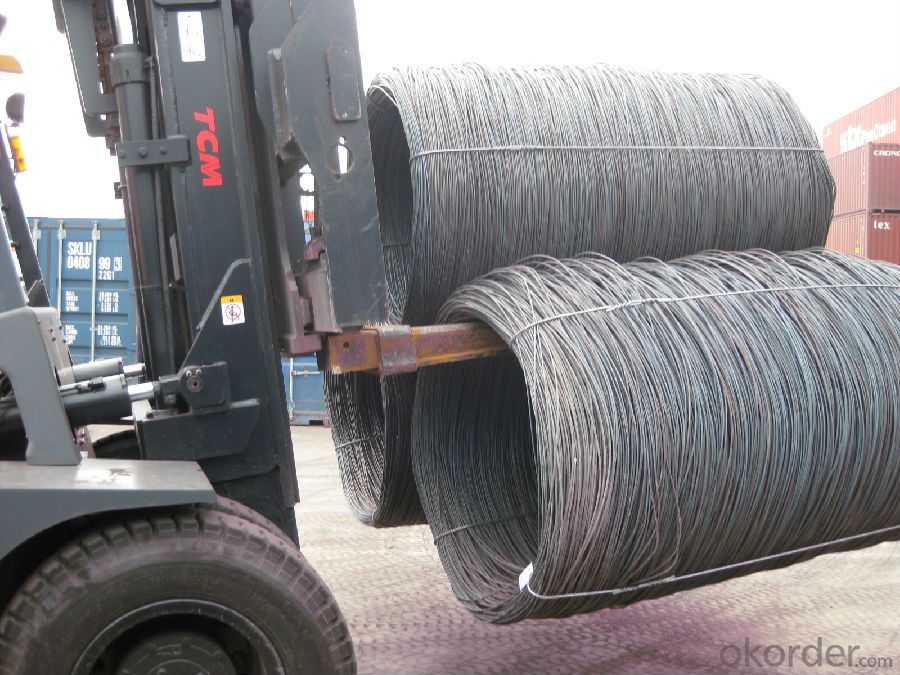
FAQ of SAE1006Cr Carbon Steel Wire Rod 7.5mm for Welding:
Q1: Why buy Materials & Equipment from OKorder.com?
A1: All products offered byOKorder.com are carefully selected from China's most reliable manufacturing enterprises. Through its ISO certifications, OKorder.com adheres to the highest standards and a commitment to supply chain safety and customer satisfaction.
Q2: How do we guarantee the quality of our products?
A2: We have established an advanced quality management system which conducts strict quality tests at every step, from raw materials to the final product. At the same time, we provide extensive follow-up service assurances as required.
Q3: How soon can we receive the product after purchase?
A3: Within three days of placing an order, we will begin production. The specific shipping date is dependent upon international and government factors, but is typically 7 to 10 workdays.
Q4: What makes stainless steel stainless?
A4: Stainless steel must contain at least 10.5 % chromium. It is this element that reacts with the oxygen in the air to form a complex chrome-oxide surface layer that is invisible but strong enough to prevent further oxygen from "staining" (rusting) the surface. Higher levels of chromium and the addition of other alloying elements such as nickel and molybdenum enhance this surface layer and improve the corrosion resistance of the stainless material.
Q5: Can stainless steel rust?
A5: Stainless does not "rust" as you think of regular steel rusting with a red oxide on the surface that flakes off. If you see red rust it is probably due to some iron particles that have contaminated the surface of the stainless steel and it is these iron particles that are rusting. Look at the source of the rusting and see if you can remove it from the surface.
- Q: How are steel wire rods used in the manufacturing of wire brushes for cleaning surfaces?
- Wire brushes used for cleaning surfaces rely heavily on steel wire rods as a key component. These rods are typically crafted from top-notch steel, guaranteeing the wire brushes' long-lasting nature and sturdiness. The manufacturing process commences with the careful selection of an appropriate steel wire rod. This rod is then cut into small sections, each measuring the desired length. These sections are subsequently straightened and fed into a machine, where a series of procedures is carried out to transform them into the bristles of the wire brush. Upon entering the machine, the wire rod sections undergo an initial twisting process, resulting in a tightly twisted bundle of bristles. This twisting procedure effectively secures the bristles together, preventing any loosening during usage. The twisted wire bundle is then inserted into a metal ferrule, serving as the handle of the wire brush. The ferrule is either crimped or soldered onto the twisted bundle, firmly attaching it to the handle. This ensures that the brush remains intact even during intense cleaning activities. Once the bristles are securely attached, the wire brush undergoes further manufacturing processes to achieve its final shape and functionality. This may involve trimming the bristles to a specific length, shaping them into a flat or angled profile, or even incorporating additional features such as scraper blades or abrasive pads. The utilization of steel wire rods in the production of wire brushes offers numerous advantages. The high tensile strength of steel ensures that the bristles maintain their shape and stiffness, facilitating effective and efficient cleaning. Furthermore, steel wire rods exhibit exceptional resistance to wear and corrosion, making them ideal for demanding cleaning applications. In conclusion, steel wire rods hold immense significance in the manufacturing of wire brushes for surface cleaning. They provide the necessary strength, durability, and flexibility required for efficient cleaning, enabling wire brushes to effectively eliminate dirt, grime, and debris from various surfaces.
- Q: How is steel wire rod used in the manufacturing of suspension cables for bridges?
- Due to its strength and durability, steel wire rod is crucial for producing suspension cables used in the construction of bridges. These cables bear the weight of the bridge deck and transfer the load to the bridge towers or anchorages. To enhance their mechanical properties, steel wire rods undergo a series of heat treatments during the manufacturing process. This includes annealing, which softens the steel and increases its malleability, as well as quenching and tempering, which enhance its strength and toughness. These treatments enable the wire rods to withstand the high tension and stress experienced by suspension cables. Once the wire rods have been appropriately treated, they are further processed into wire strands by twisting multiple wire rods together. These wire strands are tightly wrapped around a central core, forming the main body of the suspension cables. The number and arrangement of the wire strands may vary depending on the bridge's design and load requirements. Using steel wire rod in suspension cables offers several advantages. Its high tensile strength enables the cables to resist the significant forces exerted on the bridge, including the weight of the deck, live loads, wind loads, and seismic forces. Additionally, the durability of steel wire rod ensures that the suspension cables can maintain their structural integrity for many decades. Furthermore, steel wire rod is highly resistant to corrosion, making it suitable for outdoor applications, even in harsh environments. This corrosion resistance is especially important for suspension cables, as they are continuously exposed to environmental factors like moisture, humidity, and temperature fluctuations. By utilizing steel wire rod, the risk of deterioration and failure due to corrosion is significantly reduced, ensuring the longevity and safety of the bridge. In conclusion, steel wire rod plays a vital role in the production of suspension cables for bridges. Its strength, durability, and corrosion resistance make it an ideal material for withstanding the high tension and stress experienced by the cables. By utilizing steel wire rod, suspension cables can provide the necessary support to bridges, ensuring their long-term structural integrity and safety.
- Q: How are steel wire rods used in the manufacturing of wire baskets for storage?
- Steel wire rods are a vital ingredient in the production of wire baskets used for storage. These rods act as the foundational material from which the wire baskets take shape. Typically, they are made from top-notch steel to guarantee the durability and strength of the final product. To initiate the manufacturing process, the steel wire rods undergo a cleaning and straightening procedure to eliminate any bends or twists. This step is crucial in ensuring that the wire baskets are formed with utmost precision and accuracy. Once the wire rods are straightened, they are fed into a wire drawing machine. This machine gradually reduces the diameter of the rods, resulting in thinner wires. These thinner wires are then wound onto large spools, ready for use in constructing wire baskets. The subsequent step involves shaping the wire rods into the desired form for the wire baskets. This is achieved through wire forming, a process that involves bending and manipulating the wires using specialized machinery. Meticulous shaping of the wire rods allows for the creation of the frame and mesh structure of the wire baskets. After the wire rods have been shaped, they are joined together at the joints through welding to ensure stability and strength. Welding is crucial in guaranteeing that the wire baskets can bear the weight of the items stored inside. Upon completion of the welding process, the wire baskets undergo a finishing treatment. This may include surface treatments like galvanization or powder coating to enhance their resistance to corrosion and improve their aesthetic appearance. In conclusion, steel wire rods play a critical role in the manufacturing of wire baskets used for storage. They provide the necessary strength and durability that enable these baskets to endure heavy loads and have a long lifespan. Without steel wire rods, it would be impossible to create wire baskets suitable for storage purposes.
- Q: What are the common industry certifications for steel wire rod professionals?
- Some common industry certifications for steel wire rod professionals include the American Society for Testing and Materials (ASTM) certifications, the American Welding Society (AWS) certifications, and the International Organization for Standardization (ISO) certifications. These certifications validate the knowledge and skills of professionals in the steel wire rod industry, ensuring compliance with industry standards and regulations.
- Q: What are the main challenges in manufacturing steel wire rod?
- There are several main challenges in manufacturing steel wire rod. One of the challenges is ensuring consistent quality and uniformity in the wire rod production. This involves maintaining precise control over the chemical composition and mechanical properties of the steel, as any deviation can affect the performance and reliability of the final product. It requires strict adherence to quality control procedures and continuous monitoring throughout the manufacturing process. Another challenge is achieving the desired dimensional accuracy and surface finish of the wire rod. This involves controlling the temperature and speed during the rolling process to ensure proper shape and size. Any irregularities or defects in the wire rod can affect its strength and durability, making it unsuitable for its intended applications. Maintaining a high production rate while ensuring safety and minimizing downtime is also a significant challenge. Steel wire rod manufacturing typically involves complex machinery and equipment, which require regular maintenance and monitoring to prevent breakdowns. Additionally, ensuring worker safety in such an environment requires implementing strict safety protocols and providing appropriate safety equipment. Environmental sustainability is another challenge in manufacturing steel wire rod. The production process involves high energy consumption and emissions of greenhouse gases. Reducing the environmental impact requires implementing energy-efficient technologies, recycling and reusing waste materials, and adopting sustainable practices throughout the entire production chain. Furthermore, the steel wire rod industry faces the challenge of increasing competition and fluctuating market demands. Manufacturers need to stay updated with the latest market trends, adapt to changing customer requirements, and constantly innovate to remain competitive. This includes investing in research and development to improve product quality, develop new alloys, and explore alternative manufacturing methods. Overall, manufacturing steel wire rod requires addressing challenges related to quality control, dimensional accuracy, safety, environmental sustainability, and market competitiveness. Overcoming these challenges requires a combination of advanced technology, skilled workforce, and continuous improvement in manufacturing processes.
- Q: What are the safety precautions when handling steel wire rod?
- When handling steel wire rods, it is important to follow several safety precautions. Firstly, workers should always wear appropriate personal protective equipment (PPE) such as gloves, safety glasses, and steel-toed boots to protect themselves from potential injuries. Additionally, it is crucial to ensure a proper lifting technique and use mechanical lifting equipment such as cranes or forklifts when moving heavy wire rods to prevent strain or back injuries. Workers should be cautious of sharp edges or protrusions on the rods and handle them with care to avoid cuts or punctures. Regular inspections of the wire rods for any defects or damage should be conducted, and if any issues are identified, they should be reported and addressed promptly. Lastly, workers should be trained on proper handling procedures and be aware of emergency protocols in case of accidents or injuries. Overall, following these safety precautions will help minimize the risks associated with handling steel wire rods.
- Q: How is steel wire rod used in the manufacturing of wire for automotive seat belts?
- Steel wire rod plays a crucial role in manufacturing wire for automotive seat belts, as it possesses exceptional strength and durability. Through a series of processes, the wire rod undergoes a transformation into the final wire used in seat belts. To begin, careful selection of the steel wire rod is conducted based on its specific properties, such as tensile strength and flexibility. Typically made from high-carbon steel, the rod is designed to endure the intense forces experienced during accidents. Subsequently, the selected steel wire rod is subjected to a process known as cold drawing. This process involves reducing the rod's diameter by pulling it through a series of dies, resulting in a thinner and more uniform wire. Cold drawing enhances the wire's strength and improves its surface finish. After cold drawing, the wire is commonly coated with a layer of zinc via galvanization. This coating acts as a protective barrier against corrosion, ensuring the wire remains resilient and reliable over time, even in harsh environments. The coated wire is then further processed to meet the specific requirements of automotive seat belts. Typically, it is wound onto spools or bobbins, ready to be fed into seat belt manufacturing machines. During the seat belt assembly process, the wire is cut to the desired length and threaded through the seat belt webbing. This wire provides the necessary strength and support to the seat belt, effectively restraining passengers during sudden stops or accidents. Overall, the utilization of steel wire rod in the manufacturing of wire for automotive seat belts plays a critical role in ensuring the safety and reliability of these vital safety devices. The steel wire rod's exceptional strength, durability, and resistance to corrosion make it an ideal material for seat belt production, providing peace of mind to manufacturers and consumers alike.
- Q: What are the safety considerations when handling steel wire rods?
- When handling steel wire rods, there are several important safety considerations to keep in mind. 1. Personal Protective Equipment (PPE): It is essential to wear the appropriate PPE to protect yourself from any potential hazards. This may include safety glasses, gloves, and steel-toed boots to prevent injuries from falling rods or accidental contact. 2. Proper Lifting Techniques: Steel wire rods can be heavy and awkward to handle. It is crucial to use proper lifting techniques, such as bending your knees and lifting with your legs, to prevent strains or back injuries. 3. Storage and Handling: Steel wire rods should be stored in a designated area that is well-organized and secure. They should be stacked in a stable manner to prevent them from falling over and causing injuries. Additionally, it is important to ensure that the rods are not exposed to moisture or extreme temperatures, as this can affect their integrity. 4. Sharp Edges and Points: Steel wire rods often have sharp edges and points, which can cause cuts or puncture wounds. It is important to handle them with care and use appropriate tools, such as wire cutters or pliers, to avoid direct contact with the sharp areas. 5. Transport and Loading: When transporting or loading steel wire rods, it is essential to secure them properly to prevent them from shifting or falling during transit. This may involve using appropriate tie-downs, straps, or other restraints to keep the rods in place. 6. Training and Awareness: All individuals handling steel wire rods should receive proper training on safe handling procedures and be aware of potential hazards. Regular safety meetings and reminders can help reinforce the importance of following safety protocols. By considering these safety measures, you can help mitigate the risks associated with handling steel wire rods and ensure a safe working environment for all involved.
- Q: What are the different types of steel wire rod finishes for improved chemical resistance?
- There are several types of steel wire rod finishes that can enhance chemical resistance. These include hot-dip galvanizing, zinc plating, epoxy coating, and stainless steel coating. Each of these finishes provides a protective layer on the steel wire rod, preventing corrosion and improving its ability to withstand chemical exposure.
- Q: How is steel wire rod recycled?
- Steel wire rods can be recycled through a process called scrap metal recycling. This involves collecting discarded steel wire rods from various sources, such as construction sites or manufacturing facilities, and transporting them to recycling facilities. The recycling process typically involves sorting and cleaning the wire rods to remove any impurities or contaminants. Once cleaned, the wire rods are melted down in a furnace and then solidified into new steel products, including wire rods, through a casting or rolling process. This recycling method helps conserve natural resources, reduce energy consumption, and minimize waste.
Send your message to us
SAE1006Cr Carbon Steel Wire Rod 7.5mm for Welding
- Loading Port:
- Shanghai
- Payment Terms:
- TT OR LC
- Min Order Qty:
- 100 m.t
- Supply Capability:
- 30000 m.t/month
OKorder Service Pledge
OKorder Financial Service
Similar products
Hot products
Hot Searches
Related keywords


